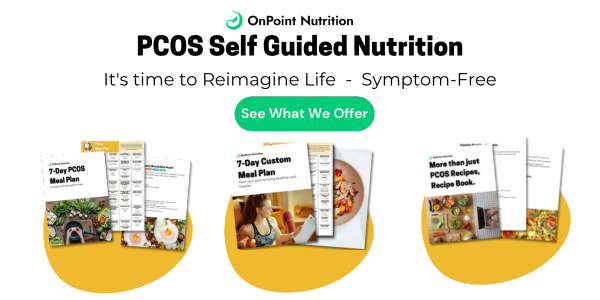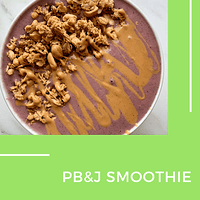
Want a playbook on how to improve your prediabetes symptoms and perhaps even reverse your condition? You have come to the right place. There are certain lifestyle changes that can help lower the risk of prediabetes advancing to Type 2 Diabetes. While many of these are related to food, the amount of activity in your daily life plays a large factor as well. Check out our tips to improving or even reversing your prediabetes!
Practice Portion Control
Portion control is an important piece of reversing prediabetes. Portioning carbohydrate-containing foods can help ensure our blood sugar responds appropriately. The idea is to make sure your blood sugar does not experience drastic spikes, which can be avoided by controlling the amount of carbohydrate you're ingesting at one time.
Portion control also promotes weight loss, which is in helpful reversing prediabetes in people who are overweight. Weighing and measuring foods can provide awareness of the amount of certain foods you're eating. This can help you identify what an appropriate portion size is for foods in general and also allows you to portion higher calorie foods more appropriately. Try these tricks to ensure you're eating appropriate portion sizes.
Use smaller dinnerware: Research shows that the size of our eating vessels and utensils subconsciously effect how much food we eat. Larger plates and bowls can cause us to view portions as smaller, and the reverse is true for using smaller dinnerware. Using smaller plates and bowls can help with portioning food appropriately and will leave you feeling more satisfied.
Use the Plate Method: You may have seen the plate method used by MyPlate before. It's pretty simple, all you do is use your plate to portion out your food. The recommended portions are to have 1/2 of your plate vegetables, 1/4 of your plate starch, and 1/4 of your plate protein. See our example of an appropriately portioned plate below!
.png?width=400&name=Portion%20Your%20Plate%20(1).png)
Ask for a to-go box: Restaurant portion sizes tend to be much bigger than the recommended portion sizes or even our normal portions at home. When there's more food on your plate, you're more likely to over eat. One of the best ways to avoid this is to ask for a to-go box to come out with your meal. This way, before you even eat, you can set aside an appropriate portion size and have the remainder wrapped up. Out of sight, out of mind!
Choose Water Over Sugary Drinks
Take some time to think about all of the beverages you drink during the day. You may be thinking of things such as water, coffee, soda, energy drinks, or alcohol to name a few. All of these drinks, aside from water, can contain extra calories and added sugars. Having one here and there may not seem like a big deal, but in the grand scheme of things, your sugary beverage intake could be adding up! In fact, sugary drinks are the number one source of added sugars in the American diet

Reducing added calories and sugar can help positively contribute to two really important steps in reversing prediabetes: weight loss and blood sugar control. Sugary drinks, since they are very concentrated, tend to spike blood sugar drastically and the added calories are not necessarily helpful with weight loss. Try some of these tips to reduce your sugary drink intake:
Read nutrition labels and ingredients: Food labels and advertising can often be confusing and misleading. A lot of sugary drinks that are advertised as "healthy" actually have large amounts of added sugar and calories. Be sure to look out for the added sugars in the ingredients section of the food label. Common added sugars are sucrose, glucose, fructose, maltose, dextrose, high fructose corn syrup, honey, agave, and fruit juices. The new nutrition label, which is required to be on all food products by 2021, also indicates how many grams of sugar come from added sugars. So be on the lookout for that as well.
Choose water instead: This one probably sounds easier said than done, but we have some tips and tricks to make water more appealing for those of you who love your sugary beverages. The first tip is to find a refillable water bottle that you really enjoy. For example, if you like really cold water, try to find a vessel that is insulated and keeps your water cold for a long time. The next tip is to add flavor! Fresh fruits, veggies and herbs add so much flavor to water and make them much more interesting. Next time you drink water try adding citrus, cucumbers, or herbs like mint to make your water more flavorful. The final tip is for people who typically choose soda or other carbonated beverages. Try doing a flavored seltzer water to satisfy your craving for something crisp and bubbly!
Cut back slowly: Just like anything else, sugary drinks can be a tough habit to kick. When you first start trying to cut back, you can begin by diluting sugary drinks by mixing in 1/2 cup of water. This can help ween your taste buds off of that need for sugar. Also, small changes make a big impact! If you're doing 4 flavored coffees in 1 week, try doing 3 instead. Once you feel comfortable with that change, reduce it to 2, and so on, so forthTurn to a smoothie to satisfy sweet cravings: When you're really wanting something sweet that will also hydrate you, try drinking a smoothie! Check out our favorite fruit smoothie below.
Interested in finding out how much sugar is coming from your beverages? Try taking the Beverage Breakdown quiz by Rethink your Drink!
Eat More Fiber
Unfortunately, research shows that most Americans do not even come close to reaching the recommended amount of fiber per day. In fact, the average adult should be consuming between 20-35 grams of fiber per day, but most Americans are only consuming around 15 grams! While fiber is an important piece of anyone's diet, it's especially important for people with prediabetes for these three reasons:
Fiber can help with weight loss. Foods high in fiber tend to be higher quality and contain larger amounts of nutrients. Also, fiber can help keep you full longer after a meal, reducing the likelihood of overeating.
Fiber can be helpful in lowering cholesterol, which is important because people with prediabetes have an increased risk of developing heart conditions as well.
Fiber helps control the blood sugar spike. Foods that contain fiber are digested more slowly, meaning they will cause a more gradual spike in blood sugar compared to other, more refined foods. See the diagram below. When more refined foods that are low in fiber are eaten, the blood sugar skyrockets and causes a drastic spike, sort of like mountain. When fiber-rich foods are eaten, your blood sugar ends up increasing gradually, causing it to look more like rolling hills, rather than a mountain peak. This "rolling hill" type of pattern is very desirable when it comes to blood sugar. This means that your blood sugar is never in the danger zone with drastic highs or lows!
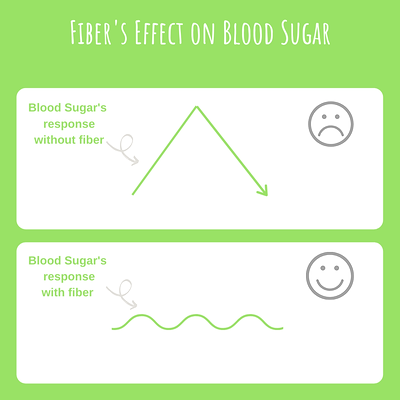
Include More Lean Proteins
Meat does not contain carbohydrates, so it will not directly affect your blood sugar. However, high fat meats contain large amounts of saturated fat, which contributes to high cholesterol. This can be concerning because prediabetes puts you at higher risk for developing heart conditions. The key is to choose lean meats more often than not. Check out our list of heart-healthy proteins to include:
- Chicken breast
- Egg whites
- Beans and legumes
- Tofu and Tempeh
- Salmon
- Turkey
Remember, it's not that you have to completely cut out your beloved red meats. It's just about including lean proteins more often than not and saving the higher fat red meats for special occasions. Are you wondering how to incorporate these lean meats into your life? Check out some of our favorite recipes below:
Tofu Chili Lime Bowls
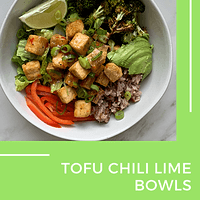 If trying to incorporate tofu into your meals, you will love this protein bowl recipe! Tofu takes on the flavor of whatever you cook it with. This sweet chili lime sauce is flavorful, easy to make, and low in fat and calories! It beats take out any day of the week. We like it because the lime flavor infuses throughout the rest of the dish. Plus, the bell peppers and brown rice provide the fiber to keep you feeling full and moderate your blood sugar
If trying to incorporate tofu into your meals, you will love this protein bowl recipe! Tofu takes on the flavor of whatever you cook it with. This sweet chili lime sauce is flavorful, easy to make, and low in fat and calories! It beats take out any day of the week. We like it because the lime flavor infuses throughout the rest of the dish. Plus, the bell peppers and brown rice provide the fiber to keep you feeling full and moderate your blood sugar
Roasted Salmon and Mixed Veggies
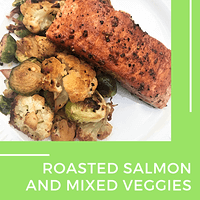 Foil packets are an excellent way to make flavorful dishes with easy clean up! Try this recipe and get two servings of veggies along with a heart healthy dose of omega-3 fatty acids from salmon. Although simple and easy, this recipe is nutritionally balanced. Add a complex carbohydrate such as brown rice, quinoa, or garbanzo beans for added fiber.
Foil packets are an excellent way to make flavorful dishes with easy clean up! Try this recipe and get two servings of veggies along with a heart healthy dose of omega-3 fatty acids from salmon. Although simple and easy, this recipe is nutritionally balanced. Add a complex carbohydrate such as brown rice, quinoa, or garbanzo beans for added fiber.
Jalapeno Black Bean Burgers
 These spicy plant-based burgers are full of protein and spice. They go so well on top of a salad or on a bun with all your favorite toppings!
These spicy plant-based burgers are full of protein and spice. They go so well on top of a salad or on a bun with all your favorite toppings!
Be More Active
Physical activity is an important piece of an overall healthy lifestyle, but can be even more important for people with prediabetes. Research shows that physical activity in people with prediabetes helps with achieving weight loss and increasing the action of insulin. Insulin resistance is one of the main markers of prediabetes. Incorporating more physical activity has been shown to positively affect insulin action, causing your body to utilize glucose more appropriately. This results in more consistent blood sugar regulation.
Aside from the positive effect on insulin, physical activity also helps with weight loss, which we've previously discussed as one of the main prediabetes prevention methods. But you may be wondering exactly how much physical activity is enough to see these benefits. Well, the CDC recommends achieving 150 minutes per week of moderate physical activity. Moderate activity looks different to everyone. So how do you know that your activity is considered "moderate"? Moderate activity is described as movement that allows you to still hold a conversation with someone, but you should not be able to sing with ease. This is called the "talk test". Try this out next time you're doing an activity with a friend!
The Bottom Line
A prediabetes diagnosis can be scary, but the good news is your condition can be improved or even reversed through some simple lifestyle changes. The key is to make small changes that will make a big impact in the long run. Focus on eating appropriate portions, cutting back on sugary drinks where possible, eating more fiber and lean proteins, and including more activity.
Interested in a total overhaul to better manage your prediabetes? Download our comprehensive prediabetes diet recommendations.

Kaitlyn Willwerth is a Registered Dietitian at OnPoint Nutrition. Kaitlyn's work focuses on providing individualized health and lifestyle coaching and, most importantly, support. She is a Certified LEAP Therapist and has also completed the Monash University 'Low FODMAP Diet for IBS' online training course for health professionals.


